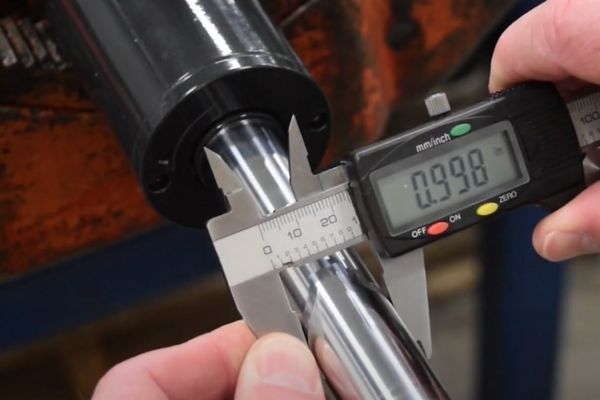Properly sized hydraulic cylinders are essential to the efficiency, life and safety of the system. Their size determines task performance, load management and equipment integration without excessive stress on the system or connected structures. This guide clarifies basic aspects and misconceptions, allowing you to make informed choices that enhance the maintenance of your hydraulic machinery.
The diameter of a hydraulic cylinder is a paramount factor influencing its force output, operational speed, and comprehensive performance within a hydraulic setup. Optimal sizing goes beyond physical accommodation, guaranteeing machinery functions at peak efficiency, safety, and dependability levels.Cylinder force correlates directly with bore diameter—larger bores generate greater force at constant hydraulic pressure, crucial for power-intensive tasks like heavy lifting or pressing. Yet, size implications extend to speed; bigger bores necessitate more fluid, affecting velocity unless compensated by elevated flow or pressure, thereby augmenting pump and system demands.A well-proportioned cylinder significantly bolsters machinery efficiency, curtailing unnecessary power usage, energy expenses, and enhancing operational smoothness and accuracy.
When selecting the appropriate size for a hydraulic cylinder, several crucial factors come into play. These include:
Choosing the right hydraulic cylinder hinges on accurately assessing the force your application demands. This force is pivotal as it dictates the necessary bore size, which influences the pressure area for force generation. To ascertain the required force, account for the load weight, gravitational effects, and supplementary factors like friction and external forces.

The stroke length of a hydraulic cylinder is the distance it extends. This measurement is vital to ensure that the cylinder can achieve the necessary reach for your application without overextending or falling short. An incorrect stroke length can render a system inefficient or even inoperative, making precise measurement and calculation of the required stroke length imperative.
Bore diameter is central to a hydraulic cylinder's force capability. Utilize the formula Area = Force / Pressure to ascertain the bore size that aligns with your system requirements. This ensures sufficient force for task execution without straining the pressure limits.

The cylinder rod's diameter is vital, particularly in compressive force applications. An appropriate rod diameter prevents buckling, enhancing the cylinder's durability and reliability. In choosing the diameter, factor in stroke length and load characteristics, as they affect the rod's buckling and bending tendencies.
Lastly, the hydraulic system's maximum operating pressure guides the cylinder sizing for sufficient force delivery without overstepping design limitations. As a constraining element, it impacts cylinder dimensions and material choices to meet system demands. Aligning operating pressure with cylinder size and capabilities guarantees optimal operation and safety.
Beyond the primary factors of size, force, and pressure, several additional considerations play a crucial role in the selection of a hydraulic cylinder. These elements ensure the cylinder not only fits your immediate requirements but also operates effectively in its intended environment over its lifespan.

We detail the different mounting methods and when they are appropriate in our article, “How to Choose the Right Telescopic Hydraulic Cylinder.”
Mounting methods such as flange, base, clevis or trunnion each have unique advantages depending on the motion requirements, load direction and space constraints. Selecting the right mounting method is critical to smooth operation, minimizing stress and extending cylinder life to avoid premature wear or failure.
Material selection for hydraulic cylinders and their parts necessitates careful attention to the operational setting and hydraulic fluid type. Factors like extreme temperatures, corrosives, and physical impacts dictate choices. Offshore cylinders may demand corrosion-resistant stainless steel or coatings, whereas high-temperature usage requires heat-tolerant seals. Construction excellence, via precision engineering, boosts durability and performance, ensuring greater reliability and lifespan.
Seals are pivotal for hydraulic system integrity, averting leaks and preserving pressure. Seal choice relies on operational conditions, such as temperature and fluid type, as diverse fluids chemically affect seal materials differently. Compatibility among seals, cylinder materials, and fluids is crucial to prevent leaks, uphold efficiency, and prolong component life.
When selecting a hydraulic cylinder for your system, there are several common pitfalls that can significantly impact the efficiency, cost-effectiveness, and safety of your operation. Being aware of these mistakes can help you make more informed decisions and ensure the longevity and reliability of your hydraulic system.
A frequent error in hydraulic cylinder selection involves incorrect sizing, whether too large or too small. Oversizing incurs unnecessary costs, prolongs cycle times, and reduces efficiency due to increased fluid volume. It also diminishes speed and hikes power consumption. Conversely, undersizing hampers task execution, posing safety risks from overload failures and accelerates wear, shortening cylinder life and necessitating more maintenance. Accurate sizing entails precise calculations of force, stroke, bore, rod diameter, and alignment with operational pressures.
Environmental considerations are vital in hydraulic cylinder selection. Temperature fluctuations can impair seal efficacy and fluid viscosity, causing leaks or inefficiencies. Corrosive environments demand material and coating choices resistant to such elements to avert early failure.
Ignoring these factors leads to frequent breakdowns, heightened maintenance expenses, and premature replacements.
Selecting the proper hydraulic cylinder size requires careful consideration. By understanding and applying the principles outlined in this guide, you can improve the performance, reliability, and safety of your system.
When in doubt, consulting a hydraulic system professional can provide additional insight and help you make the best choice for your specific needs.